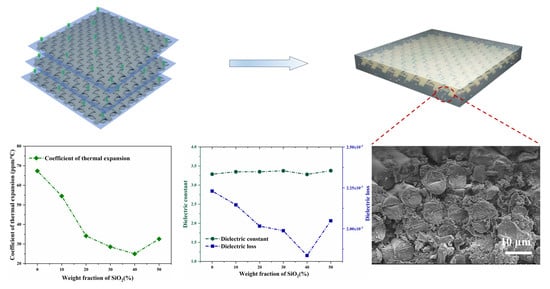Hydrocarbon Resin-Based Composites with Low Thermal Expansion Coefficient and Dielectric Loss for High-Frequency Copper Clad Laminates
Abstract
:1. Introduction
2. Experimental Procedures
2.1. Materials
2.2. GFCs Surface Modification
2.3. Preparation of SiO2/PB/SEBS/COC Solutions
2.4. Synthesis of GFC-Reinforced Resin Composites
3. Characterization
4. Result and Discussion
4.1. Microstructure Analysis
4.2. Dielectric Properties
4.3. Thermal Stability
4.4. Mechanical Properties and Water Absorption
5. Conclusions
Supplementary Materials
Author Contributions
Funding
Institutional Review Board Statement
Informed Consent Statement
Data Availability Statement
Acknowledgments
Conflicts of Interest
References
- Kowalewski, J.; Eisenbeis, J.; Jauch, A.; Mayer, J.; Kretschmann, M.; Zwick, T. A MmW Broadband Dual-Polarized Dielectric Resonator Antenna Based on Hybrid Modes. IEEE Antennas Wirel. Propag. Lett. 2020, 19, 1068–1072. [Google Scholar] [CrossRef]
- Nolden, R.; Zöll, K.; Schwarz-Pfeiffer, A. Development of Flexible and Functional Sequins Using Subtractive Technology and 3D Printing for Embroidered Wearable Textile Applications. Materials 2021, 14, 2633. [Google Scholar] [CrossRef] [PubMed]
- Ge, M.; Zhang, J.; Zhao, C.; Lu, C.; Du, G. Effect of Hexagonal Boron Nitride on the Thermal and Dielectric Properties of Polyphenylene Ether Resin for High-Frequency Copper Clad Laminates. Mater. Des. 2019, 182, 108028. [Google Scholar] [CrossRef]
- Phung, T.H.; Jeong, J.; Gafurov, A.N.; Kim, I.; Kim, S.Y.; Chung, H.-J.; Kim, Y.; Kim, H.-J.; Kim, K.M.; Lee, T.-M. Hybrid Fabrication of LED Matrix Display on Multilayer Flexible Printed Circuit Board. Flex. Print. Electron. 2021, 6, 024001. [Google Scholar] [CrossRef]
- Wang, D.-H.; Tang, L.-K.; Peng, Y.-H.; Yu, H.-Q. Principle and Structure of a Printed Circuit Board Process–Based Piezoelectric Microfluidic Pump Integrated into Printed Circuit Board. J. Intell. Mater. Syst. Struct. 2019, 30, 2595–2604. [Google Scholar] [CrossRef]
- Lee, C.; Kim, S.; Jo, M.; Lee, J. Residual Interfacial Deformation in Flexible Copper Clad Laminate Occurring During Roll-to-Roll Composite Film Manufacturing. Int. J. Precis. Eng. Manuf. Green Technol. 2021, 8, 805–815. [Google Scholar] [CrossRef]
- Russ, S.H.; Gatlin, J. Ways to Hack a Printed Circuit Board: PCB Production Is an Underappreciated Vulnerability in the Global Supply Chain. IEEE Spectr. 2020, 57, 38–43. [Google Scholar] [CrossRef]
- Dai, J.; Luo, H.; Moloney, M.; Qiu, J. Adjustable Graphene/Polyolefin Elastomer Epsilon-near-Zero Metamaterials at Radiofrequency Range. ACS Appl. Mater. Interfaces 2020, 12, 22019–22028. [Google Scholar] [CrossRef]
- Yang, B.; Tu, Y.-L.; Wang, S.-X.; Zhao, S.-C.; Xia, R.; Cao, M.; Miao, J.-B.; Qian, J.-S.; Qian, C.; Zhang, Q.-L.; et al. Electrical Conductivities and Physical and Mechanical Properties of Carbon Fiber (CF) and Carbon Nano-Tube (CNT) Filled Polyolefin Nano-Composites. J. Macromol. Sci. Part B 2018, 57, 266–277. [Google Scholar] [CrossRef]
- Liu, C.; Ruan, G.; Wang, P.; Zhou, Y.; Xu, P.; Ding, Y. Synergistic Effect of ILs Modified MWCNTs on Enhanced Dielectric Properties of Silicone Rubber/POE Blends. Mater. Lett. 2019, 239, 203–206. [Google Scholar] [CrossRef]
- Chi, X.; Liu, W.; Li, S.; Zhang, X. The Effect of Humidity on Dielectric Properties of PP-Based Nano-Dielectric. Materials 2019, 12, 1378. [Google Scholar] [CrossRef] [PubMed] [Green Version]
- Meng, J.; Chen, P.; Yang, R.; Dai, L.; Yao, C.; Fang, Z.; Guo, K. Thermal Stable Honokiol-Derived Epoxy Resin with Reinforced Thermal Conductivity, Dielectric Properties and Flame Resistance. Chem. Eng. J. 2021, 412, 128647. [Google Scholar] [CrossRef]
- Li, J.; Chi, X.; Liu, W.; Min, D.; Li, S. Thermal-Oxidative Aging Effected on Dielectric Properties of Polyolefin Used for Nuclear Cables Insulation. In Proceedings of the 2019 2nd International Conference on Electrical Materials and Power Equipment (ICEMPE), Guangzhou, China, 7–10 April 2019; pp. 368–371. [Google Scholar]
- Chaudhry, A.U.; Mabrouk, A.N.; Abdala, A. Thermally Enhanced Polyolefin Composites: Fundamentals, Progress, Challenges and Prospects. Sci. Technol. Adv. Mater. 2020, 21, 737–766. [Google Scholar] [CrossRef]
- Wu, B.; Mao, X.; Wang, C.; Deng, T.; Li, R.; Xu, Y.; Tang, X. Different Organic Peroxides That Cure Low-k 1, 2-PB/SBS/EPDM Composites for High-Frequency Substrate. J. Vinyl. Addit. Technol. 2020, 26, 524–535. [Google Scholar] [CrossRef]
- Wu, B.; Xu, Y.; Wu, N.; Tang, X. Effect of Surface Functionalized SiO2 Particles Filled Polyolefin on the Dielectric Properties of Laminates. Eur. Polym. J. 2021, 155, 110570. [Google Scholar] [CrossRef]
- Wu, B.; Mao, X.; Xu, Y.; Li, R.; Wu, N.; Tang, X. Improved Dielectric and Thermal Properties of Core-Shell Structured SiO2/Polyolefin Polymer Composites for High-Frequency Copper Clad Laminates. Appl. Surf. Sci. 2021, 544, 148911. [Google Scholar] [CrossRef]
- Wu, N.; Wu, B.; Xu, Y.; Tang, X. Relationships of the Degree of C=C Double Bond Conversion with the Dielectric Properties for SiO2/1,2-PB/SBS/EPDM Composites Cured by Organic Peroxide. ChemistrySelect 2022, 7, e202104078. [Google Scholar] [CrossRef]
- Zhang, Y.; Liu, Z.; Zhang, X.; Guo, S. Sandwich-Layered Dielectric Film with Intrinsically Excellent Adhesion, Low Dielectric Constant, and Ultralow Dielectric Loss for a High-Frequency Flexible Printed Circuit. Ind. Eng. Chem. Res. 2021, 60, 11749–11759. [Google Scholar] [CrossRef]
- Zhang, X.; Zhang, Y.; Zhou, Q.; Zhang, X.; Guo, S. Symmetrical “Sandwich” Polybutadiene Film with High-Frequency Low Dielectric Constants, Ultralow Dielectric Loss, and High Adhesive Strength. Ind. Eng. Chem. Res. 2020, 59, 1142–1150. [Google Scholar] [CrossRef]
- Mahmoodi, M.J.; Hassanzadeh-Aghdam, M.K.; Ansari, R. Effects of Added SiO2 Nanoparticles on the Thermal Expansion Behavior of Shape Memory Polymer Nanocomposites. J. Intell. Mater. Syst. Struct. 2019, 30, 32–44. [Google Scholar] [CrossRef]
- Sun, L.; Zhou, H.; Zong, G.; Ou, R.; Fan, Q.; Xu, J.; Hao, X.; Guo, Q. Effects of SiO2 Filler in the Shell and Wood Fiber in the Core on the Thermal Expansion of Core–Shell Wood/Polyethylene Composites. Polymers 2020, 12, 2570. [Google Scholar] [CrossRef] [PubMed]
- Kurimoto, M.; Yamashita, Y.; Yoshida, T.; Kato, T.; Funabashi, T.; Suzuoki, Y. Influence of Nanopore Diameter on Dielectric Permittivity of Epoxy/Open Nanoporous Silica Microcomposites. IEEE Trans. Dielectr. Electr. Insul. 2018, 25, 1022–1029. [Google Scholar] [CrossRef]
- Liu, S.L.; Bian, J. Low Dielectric Loss LNT/PEEK Composites with High Mechanical Strength and Dielectric Thermal Stability. Int. J. Appl. Ceram. Technol. 2020, 17, 1341–1347. [Google Scholar] [CrossRef]
- Peng, H.; Ren, H.; Dang, M.; Zhang, Y.; Yao, X.; Lin, H. Novel High Dielectric Constant and Low Loss PTFE/CNT Composites. Ceram. Int. 2018, 44, 16556–16560. [Google Scholar] [CrossRef]
- Li, M.; Zhao, X.; Li, Y.; Wang, W.; Zhong, W.; Luo, M.; Lu, Y.; Liu, K.; Liu, Q.; Wang, Y.; et al. Synergistic Improvement for Mechanical, Thermal and Optical Properties of PVA-Co-PE Nanofiber/Epoxy Composites with Cellulose Nanocrystals. Compos. Sci. Technol. 2020, 188, 107990. [Google Scholar] [CrossRef]
- Bhongade, A.S.; Kumar Thakur, K.; Radkar, D.B. Effect of Fillers in Glass Matrix Composite Material Suitable for Light Weight and High Thermal Strength Applications. Mater. Today Proc. 2021, 38, 2217–2221. [Google Scholar] [CrossRef]
- Qi, X.; Yin, W.; Jin, S.; Zhou, A.; He, X.; Song, G.; Zheng, Y.; Bai, Y. Density-Functional-Theory Predictions of Mechanical Behaviour and Thermal Properties as Well as Experimental Hardness of the Ga-Bilayer Mo2Ga2C. J. Adv. Ceram. 2022, 11, 273–282. [Google Scholar] [CrossRef]
- Luo, C.; Karaki, T.; Wang, Z.; Sun, Y.; Yamashita, Y.J.; Xu, J. High Piezoelectricity after Field Cooling AC Poling in Temperature Stable Ternary Single Crystals Manufactured by Continuous-Feeding Bridgman Method. J. Adv. Ceram. 2022, 11, 57–65. [Google Scholar] [CrossRef]
- Chen, B.; Ding, Q.; Ni, D.; Wang, H.; Ding, Y.; Zhang, X.; Dong, S. Microstructure and Mechanical Properties of 3D Cf/SiBCN Composites Fabricated by Polymer Infiltration and Pyrolysis. J. Adv. Ceram. 2021, 10, 28–38. [Google Scholar] [CrossRef]
- Momenzadeh, N.; Miyanaji, H.; Berfield, T.A. Influences of Zirconium Tungstate Additives on Characteristics of Polyvinylidene Fluoride (PVDF) Components Fabricated via Material Extrusion Additive Manufacturing Process. Int. J. Adv. Manuf. Technol. 2019, 103, 4713–4720. [Google Scholar] [CrossRef]
- Liu, G.-W.; Zhang, Y.; Thomas, M.P.; Ullah, A.; Pharr, M.; Guiton, B.S.; Banerjee, S. Negative Thermal Expansion HfV2O7 Nanostructures for Alleviation of Thermal Stress in Nanocomposite Coatings. ACS Appl. Mater. Interfaces 2021, 13, 44723–44732. [Google Scholar] [CrossRef] [PubMed]
- Chun, H.; Park, S.-Y.; Park, S.-J.; Kim, Y.-J. Preparation of Low-CTE Composite Using New Alkoxysilyl-Functionalized Bisphenol A Novolac Epoxy and Its CTE Enhancement Mechanism. Polymer 2020, 207, 122916. [Google Scholar] [CrossRef]
- Foster, J.C.; Staiger, C.L.; Dugger, J.W.; Redline, E.M. Tuning Epoxy Thermomechanics via Thermal Isomerization: A Route to Negative Coefficient of Thermal Expansion Materials. ACS Macr. Lett. 2021, 10, 940–944. [Google Scholar] [CrossRef] [PubMed]
- Ma, P.; Dai, C.; Jiang, S. Thioetherimide-Modified Cyanate Ester Resin with Better Molding Performance for Glass Fiber Reinforced Composites. Polymers 2019, 11, 1458. [Google Scholar] [CrossRef] [Green Version]
- Wang, H.; Li, L.; Wei, X.; Hou, X.; Li, M.; Wu, X.; Li, Y.; Lin, C.-T.; Jiang, N.; Yu, J. Combining Alumina Particles with Three-Dimensional Alumina Foam for High Thermally Conductive Epoxy Composites. ACS Appl. Polym. Mater. 2021, 3, 216–225. [Google Scholar] [CrossRef]
- Wu, B.; Chen, R.; Fu, R.; Agathopoulos, S.; Su, X.; Liu, H. Low Thermal Expansion Coefficient and High Thermal Conductivity Epoxy/Al2O3/T-ZnOw Composites with Dual-Scale Interpenetrating Network Structure. Compos. Part A Appl. Sci. Manuf. 2020, 137, 105993. [Google Scholar] [CrossRef]
- Wang, H.; Wang, Q.; Zhang, Q.; Yang, H.; Dong, J.; Cheng, J.; Tong, J.; Wen, J. High Thermal Conductive Composite with Low Dielectric Constant and Dielectric Loss Accomplished through Flower-like Al2O3 Coated BNNs for Advanced Circuit Substrate Applications. Compos. Sci. Technol. 2021, 216, 109048. [Google Scholar] [CrossRef]
- Zheng, S.; Chen, H.; Chen, H.; Zhang, W.; Xue, Q.; Che, W. Cyclic Olefin Copolymer-Based Copper Clad Laminate and the Application for Low Loss Broadband Baluns. Int. J. RF Microw. Comput. Aided Eng. 2022, 32, e22956. [Google Scholar] [CrossRef]
- Ruan, M.; Yang, D.; Guo, W.; Huang, S.; Wu, Y.; Wang, H.; Wang, H.; Zhang, L. Improved Electromechanical Properties of Brominated Butyl Rubber Filled with Modified Barium Titanate. RSC Adv. 2017, 7, 37148–37157. [Google Scholar] [CrossRef] [Green Version]
- Wing, Z.N.; Halloran, J.W. Dielectric Loss in Porous TiO2. Ceram. Int. 2017, 43, 4618–4621. [Google Scholar] [CrossRef] [Green Version]
- Vo, H.T.; Todd, M.; Shi, F.G.; Shapiro, A.A.; Edwards, M. Towards Model-Based Engineering of Underfill Materials: CTE Modeling. Microelectron. J. 2001, 32, 331–338. [Google Scholar] [CrossRef]
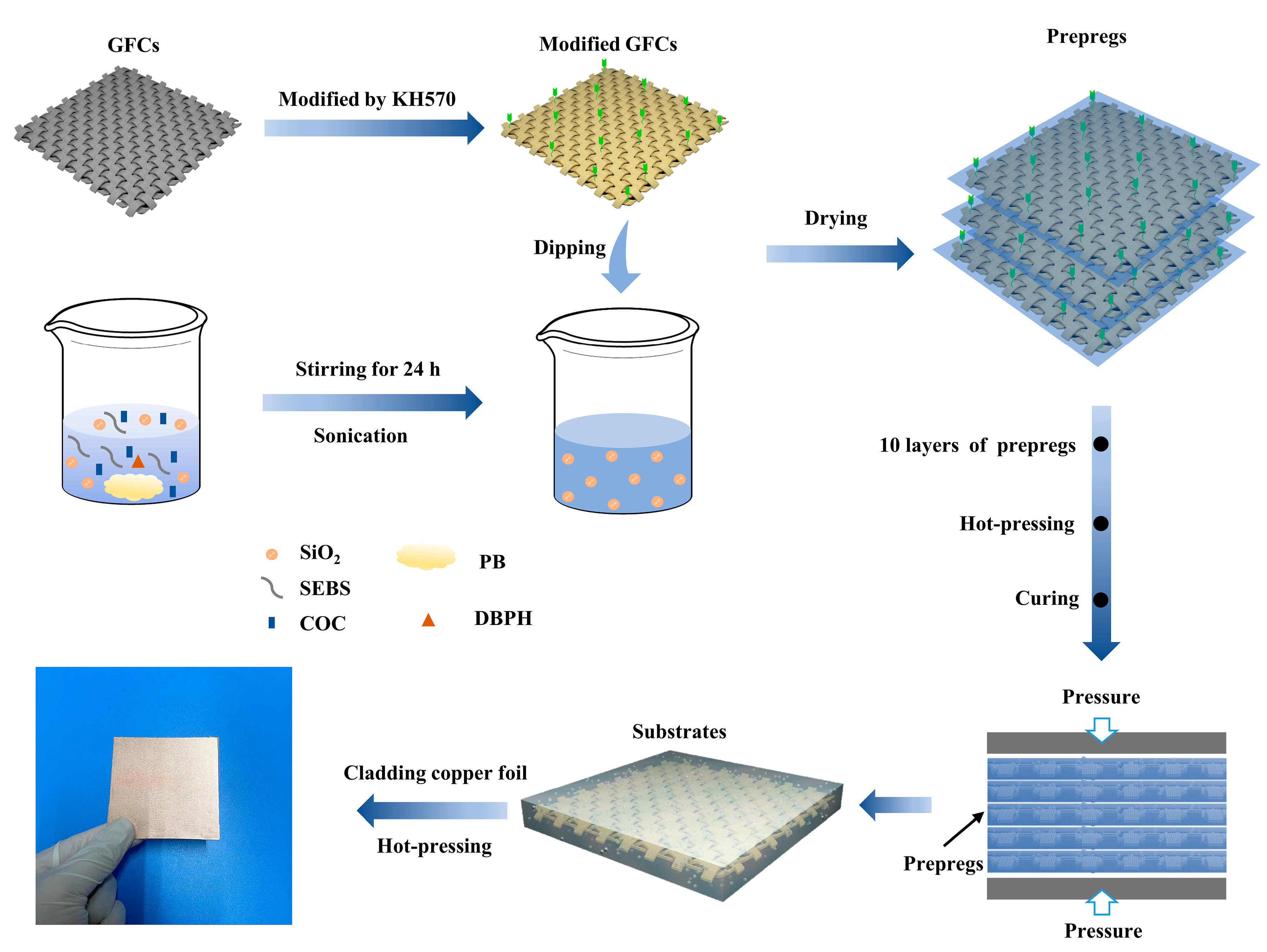
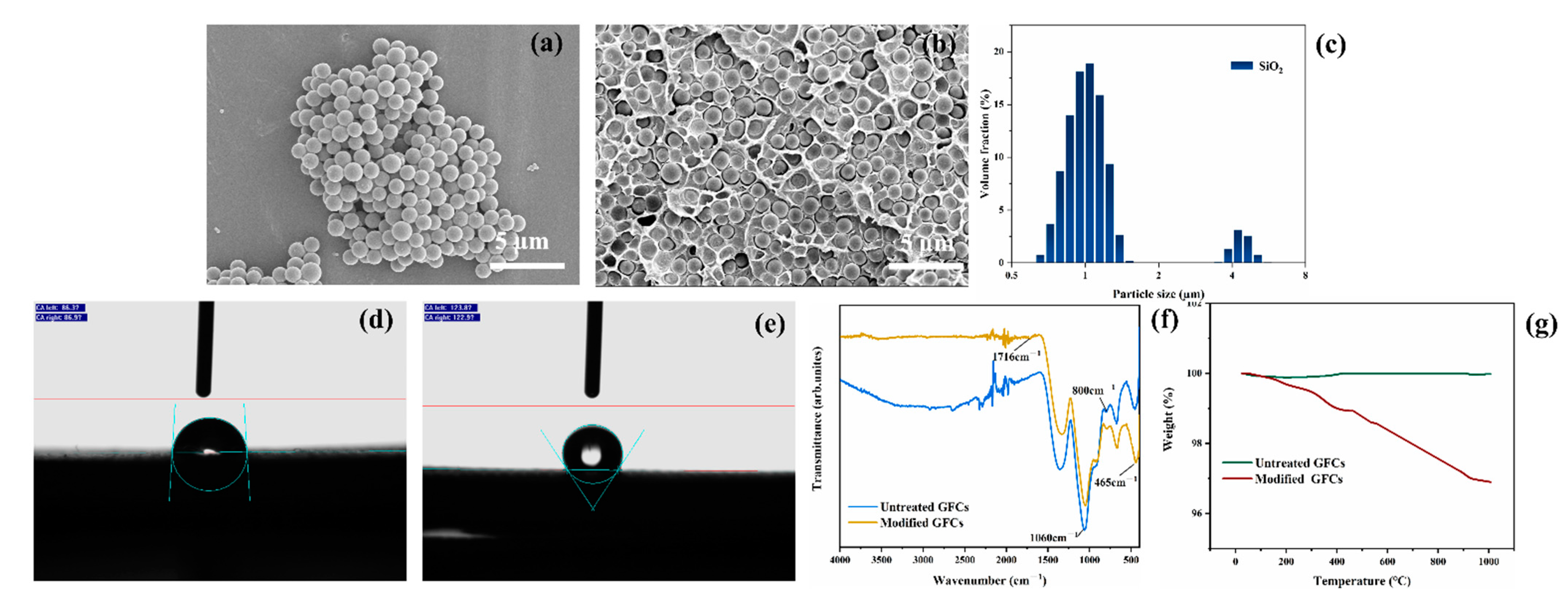

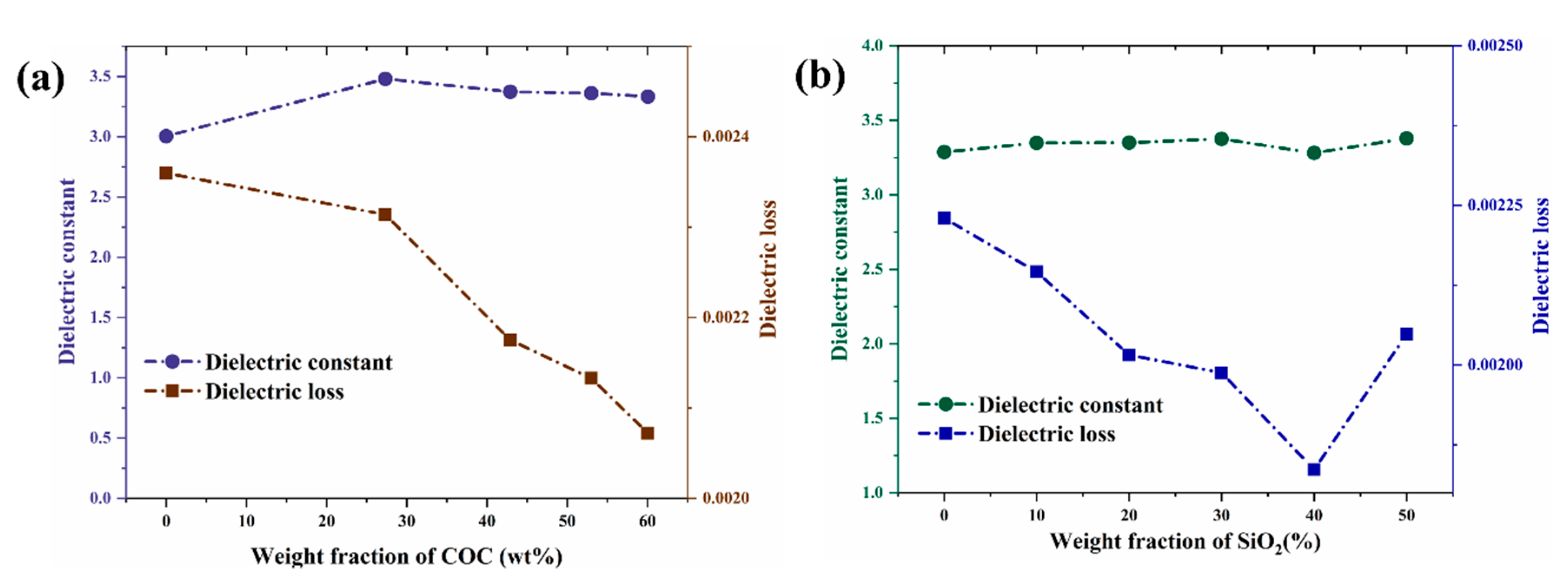


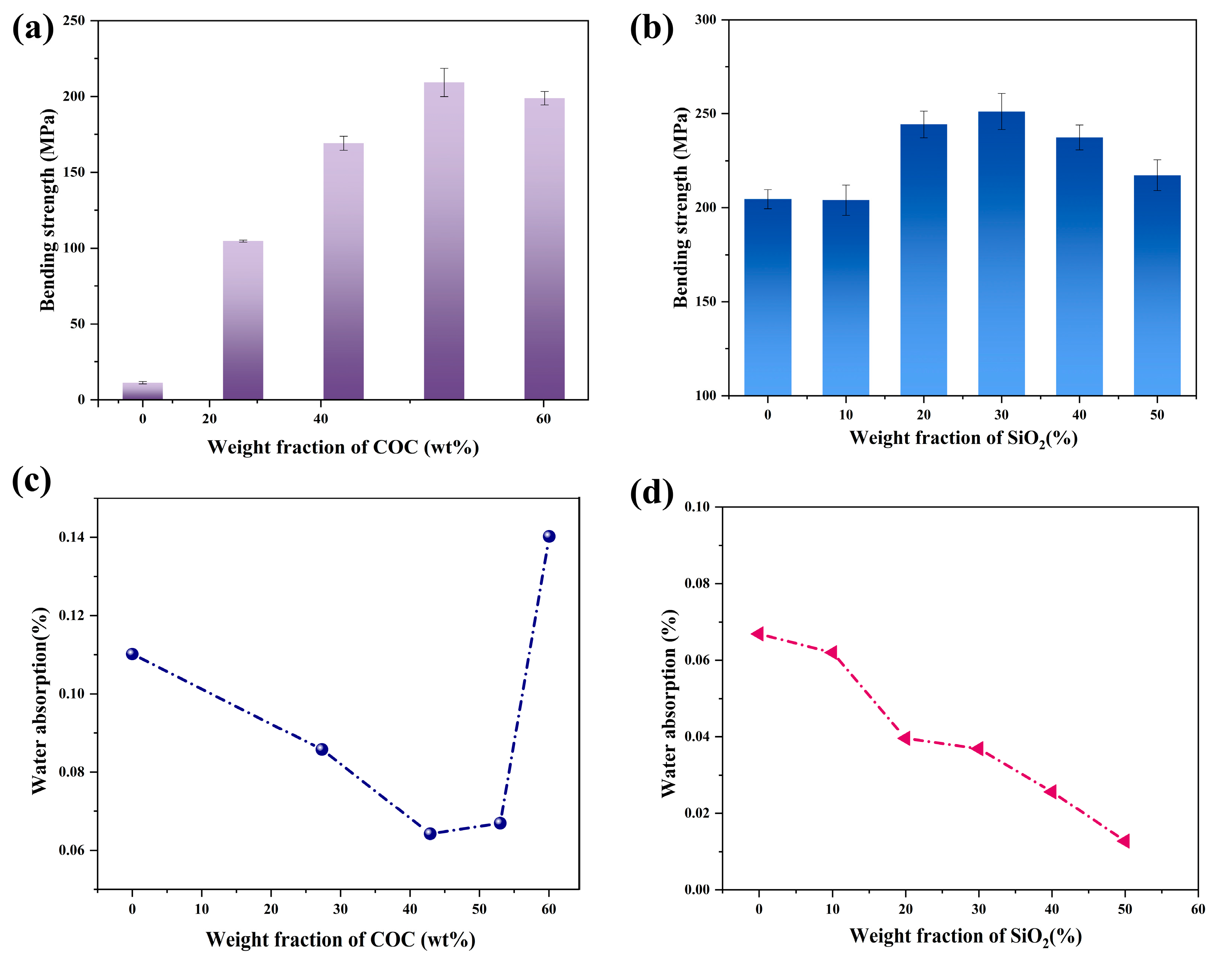
Publisher’s Note: MDPI stays neutral with regard to jurisdictional claims in published maps and institutional affiliations. |
© 2022 by the authors. Licensee MDPI, Basel, Switzerland. This article is an open access article distributed under the terms and conditions of the Creative Commons Attribution (CC BY) license (https://creativecommons.org/licenses/by/4.0/).
Share and Cite
Dong, J.; Wang, H.; Zhang, Q.; Yang, H.; Cheng, J.; Xia, Z. Hydrocarbon Resin-Based Composites with Low Thermal Expansion Coefficient and Dielectric Loss for High-Frequency Copper Clad Laminates. Polymers 2022, 14, 2200. https://doi.org/10.3390/polym14112200
Dong J, Wang H, Zhang Q, Yang H, Cheng J, Xia Z. Hydrocarbon Resin-Based Composites with Low Thermal Expansion Coefficient and Dielectric Loss for High-Frequency Copper Clad Laminates. Polymers. 2022; 14(11):2200. https://doi.org/10.3390/polym14112200
Chicago/Turabian StyleDong, Jiaojiao, Hao Wang, Qilong Zhang, Hui Yang, Jianlin Cheng, and Zhaoyue Xia. 2022. "Hydrocarbon Resin-Based Composites with Low Thermal Expansion Coefficient and Dielectric Loss for High-Frequency Copper Clad Laminates" Polymers 14, no. 11: 2200. https://doi.org/10.3390/polym14112200
APA StyleDong, J., Wang, H., Zhang, Q., Yang, H., Cheng, J., & Xia, Z. (2022). Hydrocarbon Resin-Based Composites with Low Thermal Expansion Coefficient and Dielectric Loss for High-Frequency Copper Clad Laminates. Polymers, 14(11), 2200. https://doi.org/10.3390/polym14112200





